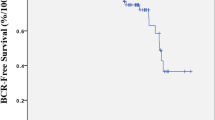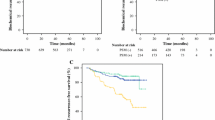Abstract
Background
This study was undertaken to investigate if the prostate-specific antigen (PSA) level measured 3 months after radical prostatectomy (RP) is a predictor of biochemical recurrence (BCR)-free survival.
Methods
We retrospectively reviewed the clinicopathologic data of 174 patients with a follow-up of at least 3 years after RP for clinically localized prostate cancer. None of the patients received neoadjuvant/adjuvant therapy. Subjects were categorized according to PSA level 3 months after RP (3M-PSA): <0.010 ng/mL (group 1; n = 119) or 0.010–0.100 ng/mL (group 2; n = 55). BCR was defined as two consecutive rises in PSA level ≥0.2 ng/mL.
Results
At a median follow-up of 69.5 months (range 36–113 months), 32 (18.4 %) patients experienced BCR. The median time to BCR was 16 months (range 4–98 months) after RP. The 5-year BCR-free survival rate was 92.6 and 57.4 % in groups 1 and 2, respectively. Patients in group 1 had a significantly higher BCR-free survival rate than those in group 2 (log-rank P < 0.001). According to the Cox proportional hazards model, patients with a 3M-PSA level of <0.010 ng/mL were at lower risk for BCR (P < 0.001), along with pathologic Gleason sum 6 (P = 0.028). PSA nadir level after RP was also a risk factor for BCR (log-rank P < 0.001). Area under the receiver operating characteristic curve for 3M-PSA to predict BCR was almost equivalent to that for the PSA nadir level (0.855 vs. 0.849).
Conclusions
3M-PSA is an independent predictor of BCR-free survival. Our findings might be used for a risk-adjusted follow-up protocol.


Similar content being viewed by others
References
Ward JF, Blute ML, Slezak J et al (2003) The long-term clinical impact of biochemical recurrence of prostate cancer 5 or more years after radical prostatectomy. J Urol 170:1872–1876
Han M, Partin AW, Pound CR et al (2001) Long-term biochemical disease-free and cancer-specific survival following anatomic radical retropubic prostatectomy. The 15-year Johns Hopkins experience. Urol Clin N Am 28:555–565
Roehl KA, Han M, Ramos CG et al (2004) Cancer progression and survival rates following anatomical radical retropubic prostatectomy in 3478 consecutive patients: long-term results. J Urol 172:910–914
Freedland SJ, Humphreys EB, Mangold LA et al (2005) Risk of prostate cancer-specific mortality following biochemical recurrence after radical prostatectomy. JAMA 294:433–439
Vesely S, Jarolim L, Schmidt M et al (2013) Parameters derived from the postoperative decline in ultrasensitive PSA improve the prediction of radical prostatectomy outcome. World J Urol 31:299–304
Hong SK, Park HZ, Lee WK et al (2010) Prognostic significance of undetectable ultrasensitive prostate-specific antigen nadir after radical prostatectomy. Urology 76:723–727
Kinoshita H, Kamoto T, Nishiyama H et al (2007) Prostate specific antigen nadir determined using ultra-sensitive prostate specific antigen as a predictor of biochemical progression after radical prostatectomy in Japanese males. Int J Urol 14:930–934
Doherty AP, Bower M, Smith GL et al (2000) Undetectable ultrasensitive PSA after radical prostatectomy for prostate cancer predicts relapse-free survival. Br J Cancer 83:1432–1436
Shen S, Lepor H, Yaffee R et al (2005) Ultrasensitive serum prostate specific antigen nadir accurately predicts the risk of early relapse after radical prostatectomy. J Urol 173:777–780
Haese A, Huland E, Graefen M et al (1999) Ultrasensitive detection of prostate specific antigen in the followup of 422 patients after radical prostatectomy. J Urol 161:1206–1211
Eisenberg ML, Davies BJ, Cooperberg MR et al (2010) Prognostic implications of an undetectable ultrasensitive prostate-specific antigen level after radical prostatectomy. Eur Urol 57:622–629
Simmons MN, Stephenson AJ, Klein EA (2007) Natural history of biochemical recurrence after radical prostatectomy: risk assessment for secondary therapy. Eur Urol 51:1175–1184
Zhou P, Chen MH, McLeod D et al (2005) Predictors of prostate cancer-specific mortality after radical prostatectomy or radiation therapy. J Clin Oncol 23:6992–6998
D’Amico AV, Chen MH, Roehl KA et al (2005) Identifying patients at risk for significant versus clinically insignificant postoperative prostate-specific antigen failure. J Clin Oncol 23:4975–4979
Antonarakis ES, Feng Z, Trock BJ et al (2012) The natural history of metastatic progression in men with prostate-specific antigen recurrence after radical prostatectomy: long-term follow-up. BJU Int 109:32–39
Oesterling JE, Chan DW, Epstein JI et al (1988) Prostate specific antigen in the preoperative and postoperative evaluation of localized prostate cancer treated with radical prostatectomy. J Urol 139:766–772
Partin AW, Oesterling JE (1994) The clinical usefulness of prostate specific antigen: update 1994. J Urol 152:1358–1368
Thompson IM Jr, Tangen CM, Paradelo J et al (2006) Adjuvant radiotherapy for pathologically advanced prostate cancer: a randomized clinical trial. JAMA 296:2329–2335
Bolla M, van Poppel H, Collette L et al (2005) Postoperative radiotherapy after radical prostatectomy: a randomised controlled trial (EORTC trial 22911). Lancet 366:572–578
Ganswindt U, Stenzl A, Bamberg M et al (2008) Adjuvant radiotherapy for patients with locally advanced prostate cancer—a new standard? Eur Urol 54:528–542
Briganti A, Wiegel T, Joniau S et al (2012) Early salvage radiation therapy does not compromise cancer control in patients with pT3N0 prostate cancer after radical prostatectomy: results of a match-controlled multi-institutional analysis. Eur Urol 62:472–487
Roberts SG, Blute ML, Bergstralh EJ et al (2001) PSA doubling time as a predictor of clinical progression after biochemical failure following radical prostatectomy for prostate cancer. Mayo Clin Proc 76:576–581
Boorjian SA, Thompson RH, Tollefson MK et al (2011) Long-term risk of clinical progression after biochemical recurrence following radical prostatectomy: the impact of time from surgery to recurrence. Eur Urol 59:893–899
Conflict of interest
The authors declare that they have no conflict of interest.
Author information
Authors and Affiliations
Corresponding author
About this article
Cite this article
Inoue, H., Nishimura, K., Yamaguchi, S. et al. Prostate-specific antigen measured 3 months after radical prostatectomy as a new predictor of biochemical recurrence. Int J Clin Oncol 20, 171–175 (2015). https://doi.org/10.1007/s10147-014-0681-7
Received:
Accepted:
Published:
Issue Date:
DOI: https://doi.org/10.1007/s10147-014-0681-7




